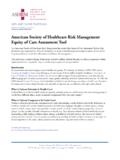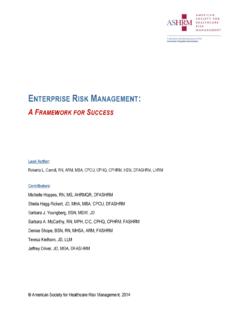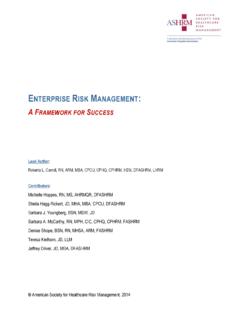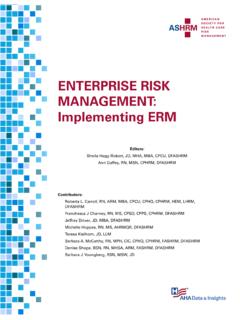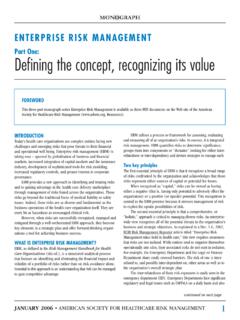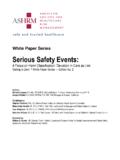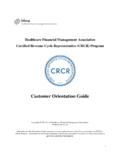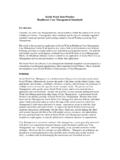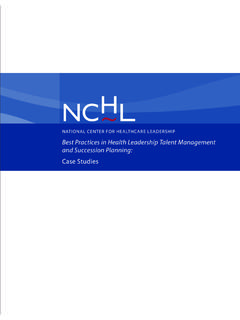Transcription of Different Roles, Same Goal: Risk and Quality …
1 Monograph Different roles , same goal : Risk and Quality management Partnering for Patient Safety _____ ASHRM Monographs Task Force FOREWORD When a patient is harmed as a result of a medical error, risk managers and Quality managers have immediate interests in identifying the circumstances that led to the error. These interests, however, can be quite divergent. Citing reasonable concerns over privilege and potential for future litigation, risk managers go to great lengths to protect information. They typically conduct an in-depth investigation to assess the liability exposure to the organization and help mitigate any future loss that may arise. Quality managers often conduct a parallel investigation. They aim to design formal process improvement initiatives that target the underlying causes of the event. Their focus has not necessarily included concerns over litigation or financial loss. Rather, their primary goal has been to improve the Quality of patient care.
2 Over the years, these separate paths have contributed to a silo mentality. In many organizations, information is too rarely exchanged between risk managers and Quality managers and collaboration is too often minimal or nonexistent. Although risk managers and Quality managers have respected and viewed each other as the experts of their respective disciplines, there was no compelling reason to address and eliminate these silos. Now there is. AMERICAN SOCIETY FOR HEALTHCARE RISK management 1 Today, as the patient safety movement continues to expand, there is growing recognition of a common ground upon which a collaborative model must be pursued. The irony is that risk managers and Quality managers have always worked to enhance patient safety. But if patient safety is to remain a shared objective, there must be a willingness to re-evaluate their respective roles from a new vantage point. This monograph is not intended to provide a national model for risk management and Quality management collaboration within a healthcare organization.
3 Rather, the intent is to encourage dialogue between the two disciplines in an effort to promote understanding, and encourage innovative thinking that will lead to a collaborative structure that benefits the organization. Such collaboration will reveal that by working together, risk management and Quality management can accomplish much more than the sum of their individual efforts. _____ INTRODUCTION Organizational structures differ No two healthcare organizations are alike, and this is notably true with respect to the risk management / Quality management structure. The structure is often driven by the size of the organization or its facilities. For smaller facilities, there may be one individual responsible for both risk and Quality management activities. This same individual may also serve as infection control officer, patient safety officer and compliance officer. This individual may or may not have had formal education and training to prepare for such a diverse role.
4 A comprehensive risk management knowledge base may not be essential for this role, particularly if the organization outsources some risk operations, such as claims management . In larger organizations, various models are employed to assure that risk is adequately managed. For some, risk management is administered from the legal department. Others employ an enterprise risk management model where responsibility for each of the enterprise risk domains is apportioned among multiple departments or individuals. There is less variety with respect to the Quality management functions within a large organization largely because the organizational focus of Quality management remains fairly stable even as new tools and measures are introduced. New terminology created Newer labels are being used to describe the various Quality management , risk management and patient safety operations within healthcare organizations. Traditional labels are still widely accepted, such as risk management , Quality management and patient safety, etc.
5 But Different permutations of these traditional labels/titles are arising. For example, some Quality management departments have been renamed departments of clinical effectiveness. In organizations where the risk management and Quality management functions are combined, a new Quality risk management department might be created. As the healthcare industry continuously strives for safer care and better outcomes, even more creative labels to describe these operations can be expected. MONOGRAPH: Different roles , same goal : RISK AND Quality management 2 SILOS AND HOW THEY DEVELOPED Quality management evolution The evolutionary tracks of risk management and Quality management have been influenced by forces demanding more and more from healthcare organizations each year. While risk managers need to keep abreast of regulations, responsibility for compliance has tended to fall upon the organization s Quality management department.
6 However, in some states where risk managers must be licensed (such as Florida), the law requires risk managers to assure compliance by overseeing these activities, and this is no small feat. Whether responsibility for these activities falls upon the risk manager or the Quality manager, the job can be daunting. The Joint Commission and the Centers for Medicare and Medicaid Services (CMS) require new standards for performance and core Quality measures each year. National Patient Safety goals are imposed upon every organization that wishes to maintain its accreditation status. And, of course, there is general pressure to adopt best practices that arise from evidence-based medicine. Mutual interest in sentinel events In 1996, the Joint Commission established its Sentinel Event Policy and incorporated it into the accreditation process. It forced healthcare organizations to do much more than simply investigate adverse events they had to analyze them more closely to identify root causes.
7 Because these events involve patient injury, risk managers recognized that malpractice claims were likely to arise from these events, and they viewed the sentinel event policy as an opportunity for earlier identification of risk. Healthcare organizations scrambled to establish their own sentinel event policies and procedures, but concerns arose over the confidentiality and privilege protection that resulted from those proceedings. In 1998, the Joint Commission responded to these concerns by revising the policy to promote self-reporting of these events. Patient safety movement gains momentum In 2001, the Joint Commission adopted patient safety standards and by 2002, a survey process was introduced using a patient tracer methodology. A change in the survey process followed: by 2006, surveys would no longer be announced. National Patient Safety goals were introduced in 2005 and healthcare organizations came to rely on Quality managers to design and implement processes that would assure compliance with these requirements.
8 While all of these accreditation requirements were being introduced by the Joint Commission, there was wider pressure to join safety and Quality initiatives promoted by other agencies, such as the Institute for Healthcare Improvement and National Quality Forum. Healthcare organizations also faced increasing pressure to publicly report Quality data. State governments were confronted with both the consumer s desire to compare Quality measures from one healthcare organization to another and to accrue, analyze and report on healthcare organizations efforts in the patient safety arena. Quality management soon gained recognition and support by executive leaders within their organizations, since the success of their efforts would affect the financial strength of the organization and directly influence its ability to recruit talented practitioners as well as new patients. AMERICAN SOCIETY FOR HEALTHCARE RISK management 3 Risk management evolution As Quality managers kept pace with all of these requirements, risk managers were confronted with their own set of challenges.
9 The healthcare industry confronted a malpractice crisis and professional liability insurance became unaffordable for many physicians and hospitals. Healthcare organizations tried to accommodate medical staffs either by lowering insurance limits or by forming captive insurance programs to provide adequate coverage. New risks were introduced as physicians opted to go bare and forgo professional liability coverage altogether. Risk managers were compelled to expand their knowledge of risk financing options as their organizations sought creative solutions to these issues. At the excess insurance level, healthcare organizations needed to demonstrate solid risk management and loss prevention programs to negotiate favorable renewal rates. At the state and national level, tort reform was promoted as a solution for those states designated by the American Medical Association as crisis states. As these reforms were enacted, risk managers were required to know and understand the specifics of their state legislation in order to competently manage claims and to evaluate liability.
10 Excessive verdicts continued to plague those states with no damage caps, and risk managers sought new ways to understand and analyze their claims in order to prevent or reduce future losses. Current perspectives As stated previously, the focus of a Quality manager can be Different from that of a risk manager. Quality management professionals focus on best possible outcomes in patient care. In addition, the Quality manager is usually responsible for assuring that the organization meets accreditation and other regulatory requirements and that outcome data are reported in an accurate and timely fashion. Through chart audits, peer reviews and other formal techniques, Quality management professionals seek out instances of suboptimal care or errors that can be remedied through process improvement. (In some respects, these Quality management activities can be viewed as proactive risk management .) Risk managers are also certainly in favor of best possible outcomes, but this may not be obvious to their Quality management colleagues who believe that risk managers are only focused on financial losses from medical malpractice claims and other forms of organizational liability.
